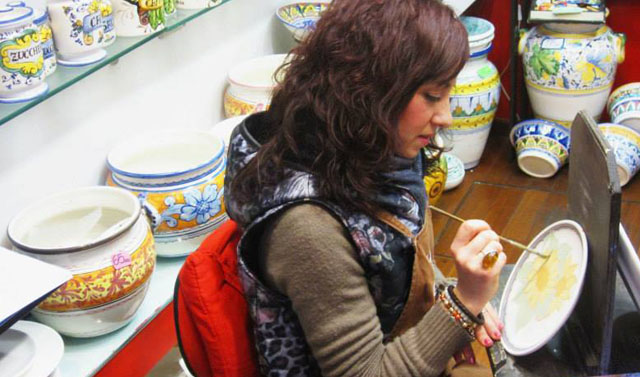
Ciao a tutti! Oggi ho un ospite sul blog. Vorrei presentarvi Gloria che gestisce il sito SpeakIta For Fun. Nelle sue parole spiega un po’ del suo obiettivo e come lei può aiutarvi con l’apprendimento della lingua! Penso che abbia buon consigli per tutti quelli che stanno imparando l’italiano da principiante agli studenti più avanzati. Nelle sue parole: Sono un insegnante online di italiano. Aiuto i principianti più timorosi a imparare l’italiano senza paure e in maniera giocosa.
Today on the blog I have a guest. I would like to introduce you to Gloria who manages the site SpeakIta For Fun. In her words, she explains a bit about her objective with her site and how she can help students learn Italian. I think her advice is great for beginners and advanced students. In her own words, she says: I am an Italian online teacher. I help the more fearful beginners learn Italian fearlessly and playfully.
Ecco Gloria. Here’s Gloria…
“L’italiano è difficile, è proprio da pazzi, è impossibile.”
“Italian is difficult, it’s just crazy, it’s impossible.”
Se avessi un centesimo per ogni volta che ho sentito questa frase…If I had a penny for every time I heard this sentence:
Molti si spaventano al solo pensiero di imparare l’italiano. Il pregiudizio più comune è “è troppo difficile”.
Lots of people are scared at the only thought of learning Italian. The most common prejudice is “it’s too difficult”.
Che tu ci creda o no, posso capirlo. Non perché penso che l’italiano sia difficile, ma perché ho avuto anch’io queste paure.
Believe it or not, I can relate to it. Not because I think Italian is difficult, but because I’ve gone through these fears.
Prima di essere un’insegnante di lingue, sono stata una studentessa di lingue, e ancora più importante, mi considero una fanatica delle lingue. Questo significa che non mi perdo mai un’occasione per imparare qualcosa di nuovo in una nuova lingua. E arrivò il momento in cui decisi di provare a imparare il tedesco.
Before being a language teacher, I was a language student, and most importantly, I consider myself a language freak. This means that I never miss an opportunity to learn something new in a new language. And the moment came when I decided to try and learn German.
Sarò sincera, non fu per niente facile. Ero da sola, senza nessuno a guidarmi, e la mia unica risorsa erano le App di lingue.
I’m not going to lie, it wasn’t easy at all. I was on my own, with no one to guide me, and my only resource were language Apps.
Mi sembrava tutto così confuso e, a peggiorare di più le cose, io sono una di quelle persone che vuole sapere tutto e ora. Quindi, immaginati una pazza mentre cerca di imparare una lingua difficile e poco familiare nel più breve tempo possibile. Sono pronta a scommettere che avevo questo aspetto:
Everything seemed so confusing to me and, to make it even worse, I’m one of those people who wants to know everything and now. So imagine a crazy woman trying to learn a difficult and unfamiliar language in the shortest possible time. I’m ready to bet I looked like this:

Alla fine ho realizzato che il mio obiettivo era quasi impossibile e che avrei fatto meglio a riconsiderare il mio approccio alla lingua tedesca.
I eventually realized my goal was nearly impossible and that I’d better reconsider my approach to German.
Dopo averci pensato per un po’, ho buttato giù una lista di cose da fare. Un promemoria per tutte le volte in cui approccerò una lingua sconosciuta di nuovo.
After thinking for a while, I came up with a to-do list. A reminder for every time I will approach an unfamiliar language again.
Dato che non voglio che nessuno abbia più problemi con l’italiano, ho deciso di condividere questi consigli con te, nella speranza che li metta in pratica quando ti avvicini all’italiano.
As I don’t want anyone to struggle with Italian anymore, I decided to share these tips with you, hoping you get to put them into practice once you approach Italian

Iniziamo! / Let’s get started
1. Prendila passo per passo / Take it step by step
Ok, lo so a cosa stai pensando: “Grazie, molto utile, lo sappiamo”.
Ok, I know what you’re thinking right now: “Thanks, very useful, we know”.
La verità è che diamo questo consiglio per scontato. Sappiamo che dovremmo imparare una lingua in maniera graduale, ma ce ne dimentichiamo. Può essere perché non vediamo l’ora di parlarla con qualcuno, o può essere perché ne siamo così tanto entusiasti e vogliamo sapere di più, di più… e di più. Quello che succede quando non facciamo piccoli passi è che cerchiamo di imparare qualcosa di nuovo ogni giorno, ci ossessioniamo aggiungendo più cose alle nostre conoscenze… e il nostro cervello esplode.
The truth is, we take this advice for granted. We know we’re supposed to learn a language gradually but we just forget about it. It might be because we’re can’t wait to speak it with someone, or it might be because we’re so enthusiastic about it and we want to know more and more… and more. What happens when we don’t take small steps is that we try to learn something new every day, we get obsessed by adding more and more to our knowledge… and our brain explodes.
Cosa dovremmo fare / What we should do
Fissarti piccoli obiettivi, possibilmente non giornalieri, e prenderti il tempo per raggiungerli è una delle chiavi per un apprendimento efficace delle lingue. Ricorda cosa dicono gli italiani: chi va piano va sano e va lontano.
Setting small goals, possibly not on a daily basis, and taking your time to reach them is one of the keys to effective language learning. Remember what Italians say: chi va piano va sano e va lontano (He who goes slowly, goes safely and goes far).
2. Usa le immagini / Use pictures
Sii sincer*: qual è il primo strumento che usi per imparare una parola nuova in una lingua straniera? Hai detto “dizionario”?
Tell me truly: what’s the first tool you use to learn a new word in a foreign language? Did you say “dictionary”?
Lo so, ho fatto la stessa cosa, come molti altri, o almeno come molti di noi.
I know, I’ve done the same thing, like many others, or at least most of us.
Non è colpa nostra. È quello che a scuola ci insegnano a fare. “Non sai cosa significa questa parola? Cercala sul dizionario.”
We’re not to blame. This is what we are taught to do at school. “You don’t know what this word means? Just look it up in a dictionary.”
Cosa dovremmo fare / What we should do
Le figure sono uno strumento fantastico e più potente per imparare il lessico nuovo. Ma come possiamo usarle esattamente per scoprire le parole nuove?
Pictures are a great and more powerful tool to learn new vocabulary, but how exactly can we use them to discover new words?
Io di solito consiglio due strategie / I usually recommend two strategies
#1 Se incontri una nuova parola in italiano, o in qualsiasi altra lingua straniera, un buon modo per scoprire il suo significato è cercarla su google. Non sai cosa significa “albero”? Prova a cercarla su Google immagini e a vedere i risultati. Ovvio, questo metodo può funzionare solo con le parole concrete.
#1 If you come across a new word in Italian, or any other foreign language, a good way to find out its meaning is by googling it. You don’t know what “albero” means? Try and type it on Google images and look at the results. Of course, this method can work only with concrete words.
#2 Se vuoi sapere come si dice una certa parola in italiano… bisogna usare il dizionario 😉 No, non ti sto prendendo in giro. Apri il dizionario, cerca la parola in italiano, poi vai a creare una flashcard abbinando un’immagine alla sua definizione in italiano. Puoi crearne con PowerPoint, stamparle, tenerle sul computer… o usare strumenti come Quizlet.
#2 If you want to know how to say a certain word in Italian… you have to open the dictionary 😉 No, I’m not making fun of you. Open the dictionary, look up the word in Italian, then go and create a flashcard by matching a picture with the Italian definition. You can make them with PowerPoint, print them, keep them on your computer… or use tools like Quizlet.

Consiglio bonus: anche mettere post-it in giro per casa può essere una buona strategia.
Bonus tip: post-it notes around the house are a great strategy too.

3) Parla dal primo giorno / Jump into speaking from day one
Di solito aspettiamo una vita prima di iniziare a parlare in una lingua straniera. A volte siamo noi a decidere di aspettare, altre volte non veniamo nemmeno incoraggiati a parlare.
Usually, we wait for ages before starting to speak in a foreign language. Sometimes we are the ones deciding to wait, sometimes we are not even encouraged to speak.
Di solito sentiamo di non sapere abbastanza o di non essere abbastanza bravi per dire le prime frasi o parole. Ed è qui che ci sbagliamo.
Usually, we feel like we don’t know enough or are not good enough to say our first words or sentences, and here’s where we are wrong.
Cosa dovremmo fare / What we should do
Parla! Hai imparato l’alfabeto? Ottimo! Dillo ad alta voce. Hai imparato i saluti? Fantastico! Ripetili a voce alta. Non devi sapere tutto prima di “emettere i tuoi primi suoni”. Parlare è la chiave per costruire la fiducia in te stess*, specialmente se ti preoccupi tanto per la tua pronuncia. Fai pratica, fai pratica, fai pratica. Ripeti quanto vuoi.
Just speak! You’ve learned the alphabet? Great! Say it out loud. You’ve learned the greeting? Fantastic! Repeat them loudly. You don’t have to know everything before you “make your first sounds”. Speaking is key to build up confidence, especially if you’re self-conscious about your pronunciation. Practice, practice, practice. Repeat as much as you want.
Attenzione / Alert!
Se preferisci aspettare e senti che per te non è il momento giusto per parlare, aspetta. Forzarlo non ti aiuterà di sicuro. Quello che puoi fare, invece, è ascoltare discorsi in italiano per prendere familiarità con i suoni e le parole e poterli infine riprodurre. Tutto arriva con il tempo, e sono sicura che quando sarai pront* farai grandi passi avanti verso la tua produzione orale in italiano.
If you prefer to wait and feel like it’s not the right time for you to speak, just wait. Force it won’t certainly help you. What you can do instead, is to listen to some Italian to become familiar with words and sounds and be able to produce them eventually. Everything comes with time, and I’m sure that when you’re ready you will make such great steps towards speaking Italian.

4) Ascolta fin dall’inizio / Listen from the very beginning
Cosa facciamo / What we do
Generalmente parlando, sentiamo che non siamo pronti per ascoltare qualcosa in italiano, o in qualsiasi altra lingua straniera, perché “siamo solo dei principianti”. Crediamo che ascoltare sia per studenti più avanzati e sappiamo per certo che non saremo capaci di cogliere il significato di tutto quanto ascoltiamo.
Generally speaking, we feel like we’re not ready to listen to Italian, or any other foreign language because we’re “just a beginner”. We believe listening is for more advanced learners and we know for sure we won’t be able to catch the meaning of everything.
Cosa dovremmo fare / What we should do
Fortunatamente, internet è pieno di opzioni per noi, tra cui YouTube. Se vuoi ascoltare alcune conversazioni naturali in italiano, puoi guardare un video che ti piace su un argomento che vuoi conoscere… e guardare quel video in slow motion. Diminuire la velocità del video diminuirà anche la velocità dell’audio. Di conseguenza, non ti sembrerà troppo spaventoso e sarai in grado di ascoltare dialoghi naturali in italiano al tuo ritmo
Luckily, the internet has got many options for us, YouTube being one of them. If you want to listen to some natural Italian, you can watch any video you like about a topic you want to know about… and watch that video in slow motion. Decreasing the video speed will also decrease the audio speed. As a result, it won’t be too daunting for you and you will be able to listen to some natural Italian at your pace.
Poi, non aspettarti di capire ogni singola parola. Spostare il focus dalle singole parole al significato generale è un modo più naturale di allenare le orecchie e aumentare la fiducia in noi stessi.
Then, don’t expect to understand every single word. Shifting the focus from single words to the general meaning is a more natural way to train our ears and boost our confidence.

Usa l’italiano nella vita quotidiana / Use Italian in your day-to-day life
Cosa facciamo / What we do
Se impariamo una lingua straniera nel nostro paese, spesso crediamo di non avere la possibilità di usarla. Sembra che tutto sia confinato nell’aula o durante il tempo che passiamo con il/la nostr* insegnante online.
If we learn a foreign language while staying in our country, we often assume we have no chance of using it. Everything remains confined in the classroom or during our time with our online teacher.
Cosa dovremmo fare /
What we should do
Cerca in ogni modo possibile di includere l’italiano nella tua vita di tutti i giorni. Conosci qualche italian* che vive nei dintorni? Fantastico! Perché non provi a salutarl* in italiano? Stai cucinando? Come si chiamano i tuoi ingredienti in italiano? Stai osservando due persone che parlano? Cosa direbbero in italiano. Come vedi, esistono diversi modi. Te ne vengono in mente altri?
Look for any possible way to include Italian in your daily life. Do you know of any Italian person living around you? Fantastic! Why don’t you try and greet them in Italian? Are you cooking? What are your ingredients called in Italian? Are you watching two people talking? What would they say in Italian? As you can see, there are plenty of ways. Can you think of some more?

Per riassumere / To sum up
- fissati obiettivi a breve termine / set short-term goals
- usa le immagini / use pictures
- non avere paura di parlare dall’inizio / don’t be afraid to speak from the beginning
- fai pratica di ascolto dal primo momento / practice listening from the first moments
- ripassa gli argomenti / revise topics
- includi l’italiano nella tua vita / include Italian in your life
Ricorda: tutto può essere facile se preso con il giusto approccio. Anche l’italiano.
Remember: everything can be easy if taken with the right approach. Even Italian.
Ora sono curiosa di sapere se hai trovato utili questi consigli e se li metterai in pratica dopo aver letto questo articolo. Se lo fai, fammi sapere i tuoi risultati.
Now I’m curious to know if you found these tips useful and if you’re going to put them into practice after reading this article. If you do, let me know your results.
Grazie Gloria! Mi piacciono i tuoi consigli! If you would like more information about Gloria and her website where she teaches beginning Italian contact her at SpeakIta For Fun












Lo amo!
Ben fatto Gloria